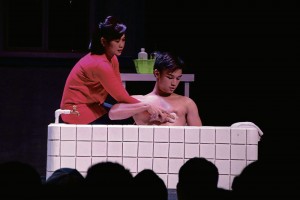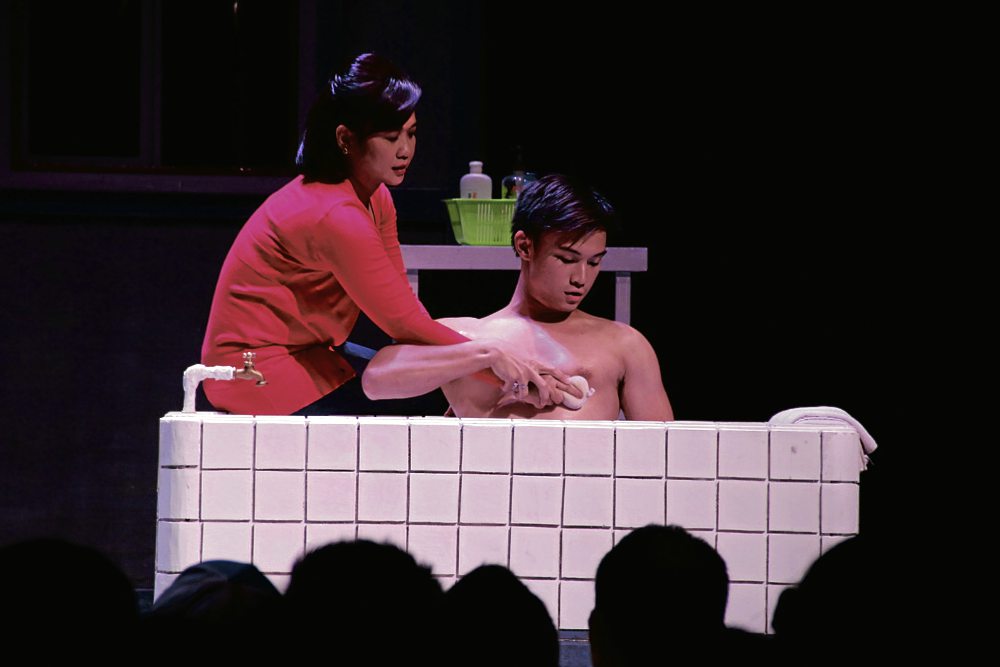
The playwright’s name above the title? It’s rare in these parts, where stellar billing routinely goes to the actors and, on occasion, to a few star directors.
Tanghalang Pilipino’s (TP) ongoing “Walang Kukurap,” however, gives its playwright Layeta Bucoy’s name pride of place above the masthead, so to speak—a gesture suggesting not only that this play’s voice and vision are unmistakably hers, but also that Bucoy’s stature is now good enough for branding, as primary audience bait.
It’s not an unjustified move. Among theater aficionados, Bucoy’s name has become synonymous with exciting, provocative drama. In a relatively brief span, she has graduated from cult favorite at the annual Virgin Labfest, where her widely lauded one-act plays first earned her serious cred, to one of the most significant dramatists of her generation, her work gracing the stage of established companies such as TP, Dulaang UP and the Philippine Educational Theater Association (Peta).

Running almost simultaneously with TP’s “Walang Kukurap,” in fact, is another Bucoy work—Peta’s “Bona,” a stage adaptation of the 1980 Lino Brocka film that starred Nora Aunor.
Because this “Bona” is a radical reworking of the original screenplay (by Cenen Ramones) about a fan’s obsession with a movie bit player, Peta gave Bucoy frontline responsibilities, alongside star Eugene Domingo and director Soxie Topacio, to sell the updated version to audiences, resulting in the playwright, and what she had to say, garnering more than decent mileage in the press coverage.
“Walang Kukurap” and “Bona” are the two major homegrown shows brave enough so far to duke it out with the international production of “The Phantom of the Opera” at the Cultural Center of the Philippines, which is hogging the lion’s share of public buzz and audience attendance. That the two share the same playwright is a rare and happy coincidence; improbably enough, and no matter how briefly (“Bona” is extended until Sept. 30; “Walang Kukurap” closes Oct. 7), it’s become the Layeta Bucoy season in local theater.
Less than ideal
It’s not easy for us to report, then, that Bucoy’s work in “Walang Kukurap” and “Bona” turns out be less-than-ideal showcases of her talent.

At her best, in her Virgin Labfest entries such as “Ellas Inocentes” (our choice for Best One-Act Play in 2007—“A hypnotic, heartbreaking portrait of a pair of warped childhoods,” we wrote then) and 2009’s “Doc Resureccion, Gagamutin ang Bayan” (“‘Energy and originality are the two vital forces of any new good play,’ said the playwright Romulus Linney. This one has both in spades”), Bucoy revealed herself as a master of the slow reveal.
These plays, directed by constant collaborator Tuxqs Rutaquio (also at the helm of “Walang Kukurap”), were marked by clipped dialogue, elliptical progression, creeping dread and skillfully held tension. Along with the less accomplished “Las Mentiras de Gloria” (2008), Bucoy’s Labfest output anatomized dark, enigmatic stories of fetid family lies and violent secrets.
Maximalist approach
That lean, disciplined voice, sad to say, seems to have been jettisoned in “Walang Kukurap” and “Bona”—two productions with energy and conviction to spare, but which are also flabby, verbose and overwrought. Gone is Bucoy’s customary sharpness, replaced by a maximalist approach to characters and situations that now often tends toward dismaying simple-mindedness by violating that cardinal creative dictum: show, don’t tell.
To be fair, the play’s director must share part of the blame. Take a representative scene in “Bona.” Late in Act 2, the screen above the stage shows film footage of the boy starlet (Edgar Allan Guzman) flubbing his lines at a shoot and getting berated by his director. Fade, then enter Bona (Eugene Domingo) and Guzman onstage, the latter fuming mad. Bona, now his factotum-cum-manager, tries to mollify the boy: “E kasi nga nakakalimot ka ng dialogue, kaya nagagalit si direk.” Cough—wasn’t that what we just saw?
Tremendous actress
A talky, repetitive quality haunts the play from the very beginning, when Domingo’s Bona, now a call-center agent, prays to an image of the Black Nazarene in her home, and practically gives away the ensuing narrative. Domingo, it must be said, is a tremendous actress, her theater background coming to the fore in her command of space, the way she deploys her vocal instrument, her ability to think on her feet (her every adlib is a hit with the audience).
Peta has said this production took pains to veer away from Aunor’s film characterization to highlight Domingo’s own strengths. Her Bona, then, much like the actress herself, is a quick-witted, self-aware and resourceful woman who doesn’t seem to suffer fools gladly. Aunor’s Bona is a hapless creature—diffident, devoid of intimate company, much put-upon in her lower-middle-class home. Domingo’s Bona, on the other hand, supplements her call-center income by tutoring Korean students basic English and doing tarot-card reading for online customers—which in private she knows to be a lark.
This woman, in short, has her wits about her. She is capable of being in on the joke, and Domingo, with her fine sense of the absurd (we have it on good authority that one of the plays she did for Dulaang UP was “Waiting for Godot”), does wonders in the early part of the play, when Bona and her best friend Baldy (Joey Paras alternating with Phil Noble) engage in funny but long-winded routines that would not have been out-of-place in Domingo’s defunct TV show “Comedy Bar.”
Reassuringly solid
But this only leads to a fundamental puzzle: How does someone like her end up a doormat to a dumb himbo—not even a hunk, but a boy-man? (Guzman is excellent, by the way—ironically the most human presence in the play.)
For all the familiar predicaments this Bona is subjected to by Bucoy and Topacio (she’s breadwinner to a family of moochers, for instance), not for a minute does her descent into desperation evince a sense of pathos, danger or horror. There is just something reassuringly, indestructibly solid about the actress playing her that prevents theatrical alchemy from dissolving our disbelief.
Stacking the deck
The playwright and the director themselves seem to have implicitly grasped this problem. How else to explain the frantic cramming they do near the end, when, to push Bona’s character into the iconic bath-water scene, they stack the deck against her to ridiculous lengths?
Brocka and Ramones’ film at this point has become a model of economy, the scenes acquiring the headlong inevitability of classic tragedy. But in the stage version, to tip Bona over the edge, she has to be walloped with a florid, melodramatic pile-up of complications. (Spoiler alert!)
First, her lout of a sister (Uleb Nieto—terrific) blames Bona over her nephew Bingo, now comatose in a hospital, because Bona’s inability to send him to school had so depressed him that “nagrebelde, napabarkada sa durugista!” and got into a fight. As wags would say, “Comatose agad!?”
Next, nuance is all but abandoned when Guzman’s Gino Sanchez is transformed into a standard-issue villain with a wordy speech that repudiates everything that he is, and twists the knife inside Bona besides: “Walang totoo d’un sa sinabi ko sa ‘Star of Tomorrow.’ Bayarang lalaki ako, Bona. Kaya ’yung nangyari sa atin, ’wag mong lagyan ng kulay ’yun ha. ’Yun din naman ang gusto mo, ’di ba—katulad ng iba?”
Loud and livid
That wholesale assault on subtlety is what also afflicts TP’s “Walang Kukurap.”
“A good way to destroy a play is to force it to prove something,” wrote theater critic Walter Kerr. “Forced it will always be. Life, caught in its complex immediacy, doesn’t present itself as a tidy equation.”
Loud and livid, “Walang Kukurap” is a play that wants to prove a point: Politics is bad—no, it is lethal. Some theatergoers have said the play is an expanded take-off from Bucoy’s “Doc Resureccion,” which also tackles the hazardous effects of small-town politics on an extended family.

Not quite so; the true antecedent of “Walang Kukurap” is last year’s “Titus Andronicus,” the Filipino adaptation of the Shakespeare bloodfest that Bucoy and Rutaquio presented via Dulaang UP.
In transposing the story of the Roman general undone by the savagery of the world he lived in into a Filipino environment of violent mayors and their henchmen, their scheming wives and homicidal kids, it was “Titus” that first lent magnified form to Bucoy and Rutaquio’s Grand Guignol appraisal of the hurlyburly of Philippine politics.
They’ve brought the same mindset to “Walang Kukurap,” which, although less bloody than “Titus,” still manages by play’s end to notch an impressive body count, among them a Chinese trader sawed to pieces; a bystander stabbed to death; the town mayor assassinated by his own wife; a conniving lawyer murdered—blood, meanwhile, spurting liberally throughout.
Horrific immediacy
This is a fierce, unblinking vision. But anyone who pronounces himself shocked, shocked! at what the play purports to unmask must be asked: Where have you been?
In real life, a mayor in a remote town in Mindanao stands accused of mowing down 58 people and burying them en masse. A leader of a violent cult murders his own wife—and gets elected to Congress; ditto with a child rapist. The president of the republic herself is caught on tape appearing to conspire not only to steal the vote but also to greenlight the abduction of a lowly government employee standing in her way.
The point is, reality has outrun art in this case. Nothing on stage—not the most realistic simulation of slaughter, not the barrels of fake blood—can top the horrific immediacy of actual, flesh-and-blood political combat.
Committed actors
“Walang Kukurap” works overtime, and its committed actors exert themselves full-throttle, to present a horror show about the rotten state of Philippine society. But, quite disappointingly, it stops at description (if a bombastic one), and proceeds no further.
So, rather than characters, we have premises dressed in human garb, their lines stripped of the hum and ding of normal speech. The daughter of a shady accountant-society-woman meets her cousin and childhood chum, now a fugitive from the law, with the words “Dito mo pa ako pinapunta sa playground where we used to play as kids.” (Note the annotative clause.) A beat later, she recalls their happy early years, “even if our respective mothers didn’t talk to each other.”
“Respective”? That looks right on paper—but to the ear it sounds laughable.
The mother, too, has her own whopper. To underline her economic status, she is saddled with a heavy-handed colegiala patois: “But iba pa rin the trees in our bayan.”
In another scene, two characters have a confrontation. “Bakit ’di na lang tayo umalis?” demands one. Reply: “I need to oversee the jueteng operation!”
For people who have supposedly lived with each other all their lives, everyone in “Walang Kukurap” seems forever explaining, italicizing, contextualizing.
And for people who are, Bucoy and Rutaquio would have us believe, steeped in a world of perpetual intrigue and treachery, these are the most loquacious and un-reticent crooks you’d meet, constantly prattling on about their “droga, pasugalan,” etc. Not to mention pathologically scared of being misunderstood the first time. “Para kang bulag,” says one. “’Di nakakakita.”
Strident obviousness
This is what you get, we wager, with a play that refuses to go no further than photographic reproduction—what critic and scholar Eric Bentley decried (in Arthur Miller, no less) as the “tendency to substitute oratory for inquiry.” “Walang Kukurap” underscores its point with strident obviousness—that our current leaders and their ways are a pox on our system—but, really, who will argue with that?
The far more consequential terrain to explore, one might think, is not that our politicians are a nasty bunch, but how they are able to get away with it. What is it in them, and about us, that would tolerate such evil?
More to the point, how do these characters in “Walang Kukurap” think—how do they weigh options, or reflect on their decisions? We have no idea, because there are no moments of introspection, no hints of private stillness anywhere in the play.
Demonizing these characters from the outset also precludes any subsequent interest in their affairs by the audience. Once they’ve been rendered so grotesquely unrecognizable to us—blackest of the black, irredeemably evil, and virtually The Other—why should we care about what happens to them?
The dynastic families in “Walang Kukurap” may decimate each other, as they do, but all we can end up summoning inside is a smug sense of moral superiority: At least we’re not like them. By that measure alone, a play that has hoisted its sense of self-importance on an announced aim to “simply unsettle” the audience has already lost.
In any case, purely from the point of view of drama, the prospect of characters with no discernible arc of growth or development, who thrash about in their preordained level of hell from beginning to end, surely only makes for inert theater.
Making sense
But, of course, there is one thing theater and art can do, and that is to try to make sense of things, to go beyond fallow presentation and description into truly fearless scrutiny, by which artist and audience can then hopefully find some insight and illumination.
“Walang Kukurap,” unfortunately, is content merely to mime a circus of horrors—a trite one at that—though it bids to be recognized as a serious piece of theater with something serious to say about Philippine politics and society.
It has to make a choice. If it is to be a political play, let it be a play first, a political tract second. Otherwise, we can spare ourselves the ritual of going to the theater, no matter how special that is, and just go online to download the manifesto. Slogans and rhetorical excess may work in the campaign trail; but onstage, a bit more artfulness does help the medicine go down.
Peta, for instance, has shown the way with its pitch-perfect blend of the didactic and the theatrical in the 2010 election-education musical “Si Juan Tamad, ang Diyablo at ang Limang Milyong Boto”—“the rare advocacy play that does NOT make the viewer feel like she’s been clubbed with a rolled-up newspaper for two hours,” wrote Jessica Zafra.
The opposite was how we felt after watching “Walang Kukurap”—forced to sit though a lecture that had all the delicacy of a sledgehammer. We do not begrudge its sincerity, only its lack of imagination.
Bucoy and Rutaquio, individually and in tandem among Philippine theater’s brightest new vanguards, can do much better than this.
Peta’s “Bona” runs until Sept. 30 at the Peta Theater Center. Call 7256244, 0917-5765400.
Tanghalang Pilipino’s “Walang Kukurap” runs until Oct. 7 at CCP’s Tanghalang Huseng Batute. Call 8321125 local 1620-1621, 8323661, 2183791, 0917-7500107, 0918-9593949.
E-mail gcadiz@inquirer.com.ph, visit www.gibbscadiz.blogspot.com, follow on Twitter @gibbscadiz.











































